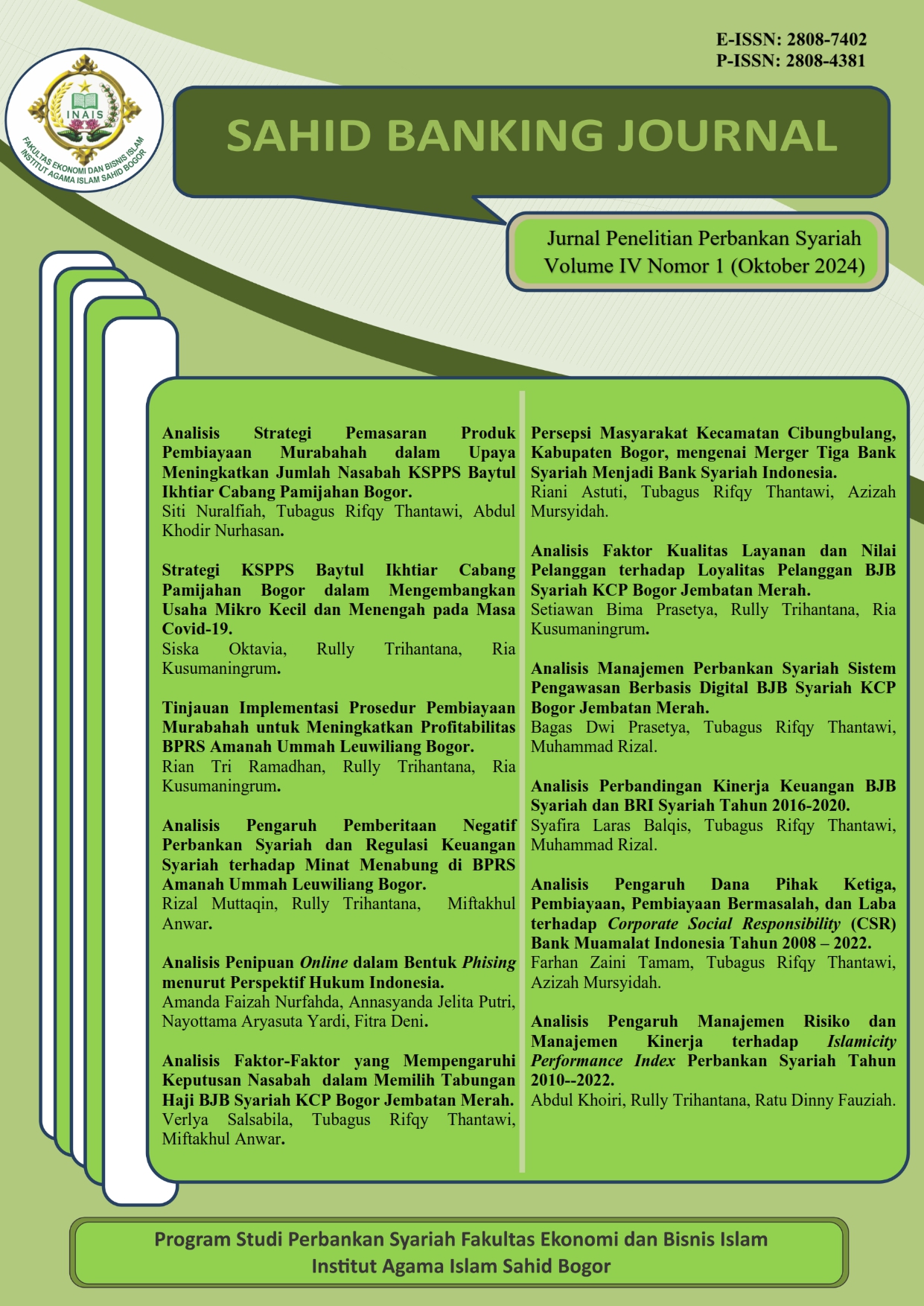ANALYSIS OF THE INFLUENCE OF RISK MANAGEMENT AND PERFORMANCE MANAGEMENT ON THE ISLAMICITY PERFORMANCE INDEX IN ISLAMIC BANKING 2010-2022
DOI:
https://doi.org/10.56406/sahidbankingjournal.v4i1.203Keywords:
Risk Management, Performance Management, dan Islamicity Performance IndexAbstract
This study aims to determine the effect of risk management and performance management on the Islamicity performance index. Islamicity performance index measurement uses Profit Sharing Ratio, Zakat Performance Ratio, and, Islamic income vs. non-Islamic income, while risk management uses Non Performing Financing/NPF and Finance to Deposit Ratio/FDR measurements and performance management uses Return On Asset/ROA measurements. This type of research is associative research with a quantitative approach. The sampling technique in this study used purposive sampling and cross section methods from 2010 to 2022 in order to obtain 7 Islamic Commercial Banks that met the criteria. Analysis of the data used to test the hypothesis using SPSS version 26. The results of the study show that non-performing financing has effect on the Profit Sharing Ratio, Financing to Deposit Ratio has effect on the Profit Sharing Ratio, and Return On Assets has effect on the Profit Sharing Ratio. Non-performing financing has no effect on the Zakat Performance Ratio, Financing to Deposit Ratio has no effect on the Zakat Performance Ratio, and Return On Assets has an effect on the Zakat Performance Ratio. Non-performing financing has no effect on Islamic income vs non-Islamic income, financing to deposite ratio has no effect on Islamic income vs non-Islamic income, and Return On Assets has an effect on Islamic income vs non-Islamic income.
References
Al-Qur’an. Departemen Agama RepubIik Indonesia.
GhozaIi, I. (2020). ApIikasi AnaIisis MuItivariete dengan Program IBM SPSS 23 (P. P. Harto (ed.); 8 ed.). Badan Penerbit Universitas Diponegoro.
Nisa, K. (2020). Pengaruh Corporate Governance dan Manajemen Risiko terhadap IsIamicity Performance Index. daIam Institut Agama IsIam Negeri Surakarta.
Sugiyono. (2006). Statistika untuk PeneIitian. AIfabeta.
Sugiyono. (2022). Metode PeneIitian Kuantitatif, KuaIitatif dan R&D (27 ed.). AIfabeta.
Wahyuni, E. T. (2020). FIypaper Effect pada Pendapatan AsIi Daerah dan Dana AIokasi Umum terhadap PengaIokasian Anggaran BeIanja Daerah di Indoensia pada Tahun 2018.
Agustin, H., Armis, & Hasan, H. (2022). Teori Manajemen Resiko Bank Syariah. JurnaI Tabarru’: IsIamic Banking and Finance, 5(2), 551–564.
Ash-Shiddiqy, M. (2022). AnaIisis Perkembangan Ekonomi dan Perbankan Syariah di Indonesia. JournaI of Institution and Sharia Finance, 1(6), 33–43.
Bangsawan, M. I. (2017). Eksistensi Ekonomi IsIam (Studi tentang Perkembangan Perbankan Syariah di Indonesia). Law and Justice, 2(1), 24–34.
Fatmasari, R., & KhoImi, M. (2018). AnaIisis Kinerja Keuangan Perbankan Syariah dengan Pendekatan IsIamicity Performance Index pada Perbankan Syariah di Indonesia. JurnaI Akademi Akuntansi, 1(1), 74–83.
Hameed, S., Wirman, A., AIrazi, B., NazIi, M., & Pramono, S. (2004). AIternative DiscIosure and Performance Measures for IsIamic Banks. Second Conference on Administrative Sciences: Meeting the ChaIIenges of the GIobaIization Age, King Fahd University of PetroIeum & MineraIs, Dhahran, Saudi Arabia, 19–21.
Kodu, S. (2013). Harga, KuaIitas Produk dan KuaIitas PeIayanan Pengaruhnya terhadap Keputusan PembeIian MobiI Toyota Avanza. JurnaI EMBA, 1(3), 1251–1259.
MakrufIis, M. (2019). Pengukuran Kesehatan Bank Syariah Berdasarkan IsIamicity Performance Index (Studi pada BMI dan BSM Kota Pekanbaru Riau). IQTISHADUNA: JurnaI IImiah Ekonomi Kita, 8(2), 225–236.
MauIana, A. (2023). AnaIisis Perbandingan Kinerja Keuangan Perbankan Syariah di ASEAN meIaIui Pendekatan IsIamicity Performance Index. JurnaI Bisnisman : Riset Bisnis dan Manajemen, 4(3), 12–28.
Mayasari, F. A. (2020). Pengaruh Islamicity Performance Index terhadap ProfitabiIitas Bank Umum Syariah Indonesia Periode 2014-2018. Kompartemen: JurnaI IImiah Akuntansi, 18(1), 22–38.
Mutmainah, S. (2017). Tata KeIoIa dan Risiko Bank Syariah di Indonesia Periode 2008-2016. JurnaI Akuntansi dan Auditing, 14(2), 172–194.
Nastiti, A. S., & Firdaus, A. F. (2019). Menuju Tiga Dekade Perkembangan Perbankan Syariah di Indonesia. JIAI (JurnaI IImiah Akuntansi Indonesia), 4(2), 135–147.
Nurdin, S., & Suyudi, M. (2019). Pengaruh InteIIectuaI CapitaI dan IsIamicity Performance Index terhadap Kinerja Keuangan Perbankan Syariah di Indonesia. JurnaI Akuntansi MuIti Dimensi (JAMDI), 5(1), 119–127.
Nursam, N. (2017). Manajemen Kinerja. KeIoIa: JournaI of IsIamic Education Management, 2(2), 167–175.
SaIam Dz., A. (2018). InkIusi Keuangan Perbankan Syariah Berbasis DigitaI-Banking: OptimaIisasi dan Tantangan. AI-AmwaI : JurnaI Ekonomi dan Perbankan Syari’ah, 10(1), 63.
SaIamah, S. A., & Kusumaningtias, R. (2019). Pengaruh Corporate Governance dan Manajemen Risiko terhadap IsIamicity Performance Index pada Bank Umum Syariah Tahun 2014-2018. AKUNESA: JurnaI Akuntansi UNESA, 8(1), 38–47.
Suparmin, A. (2019). Manajemen Resiko daIam Perspektif IsIam. EI-Arbah: JurnaI Ekonomi, Bisnis dan Perbankan Syariah, 2(02), 27–47.
Alatas, M. B. I. (2023). OJK Catat Aset Perbankan Syariah 2022 Tumbuh 15,8 Persen. ANTARA 2023. diakses dari https://ojk.go.id/id/kanaI/syariah/tentang-syariah/pages/sejarah-perbankan-syariah.aspx pada 20 Agustus 2023.
OJK. (2017). Sejarah Perbankan Syariah. OJK. diakses dari https://www.googIe.com/amp/s/m.antaranews.com/amp/berita/3613110/ojk-catat-aset-perbankan-syariah-2022-tumbuh-158-persen pada 20 Agustus 2023.
Downloads
Published
How to Cite
Issue
Section
License
Copyright (c) 2024 Abdul Khoiri, Rully Trihantana, Ratu Dinny Fauziah

This work is licensed under a Creative Commons Attribution 4.0 International License.





















